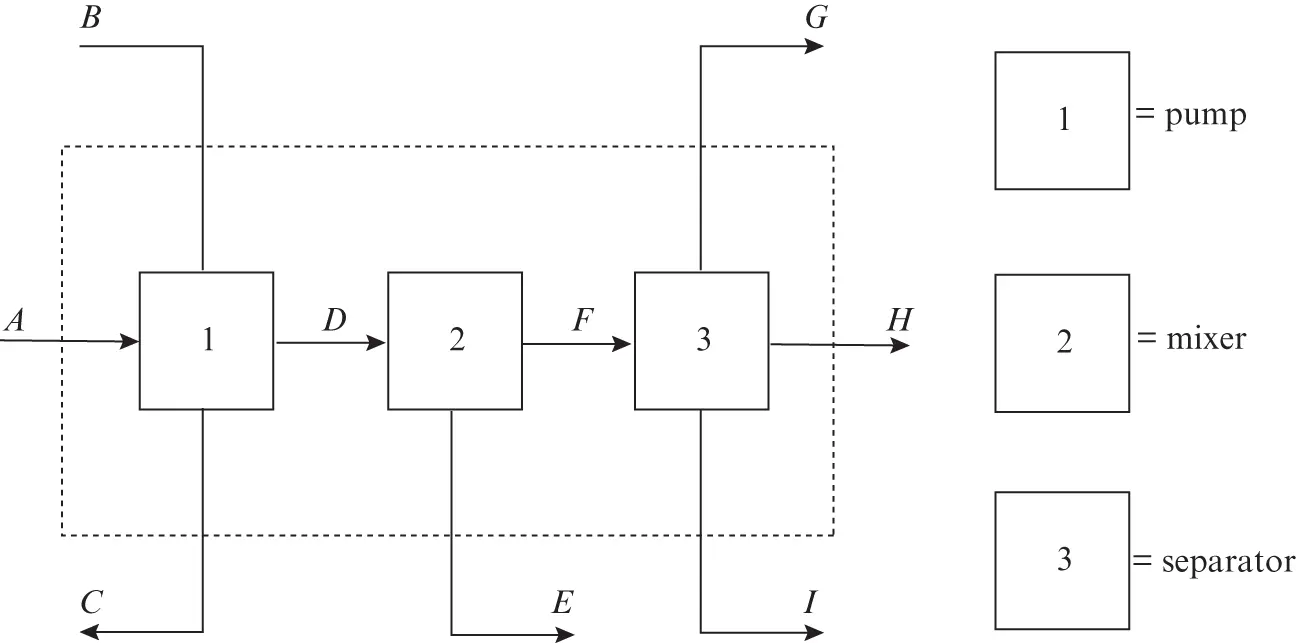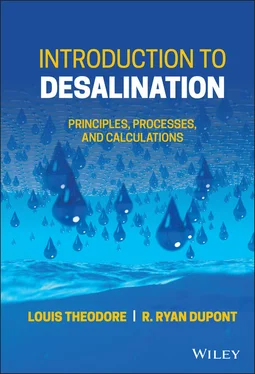| Units |
Conversion constants |
| L |
gal |
ft 3 |
m 3 |
ac-ft |
| Liters (L) |
1.0 |
0.2642 |
3.531 x 10 -2 |
0.0001 |
8.106 x 10 -7 |
| Gallons (gal) |
3.785 |
1.0 |
0.1337 |
3.785 x 10 -3 |
3.068 x 10 -6 |
| Cubic feet (ft 3) |
28.32 |
7.481 |
1.0 |
2.832 x 10 -3 |
2.296 x 10 -5 |
| Cubic meters (m 3) |
1,000 |
264.2 |
35.31 |
1.0 |
8.106 x 10 -4 |
| Acre feet (ac-ft) |
1.223 x 10 6 |
3.259 x 10 5 |
4.356 x 10 4 |
1,233 |
1.0 |
Table 3.4 Conversion constants for volumetric flowrate.
| Units |
Conversion constant |
| gpm |
L/s |
ac-ft/d |
cfs |
m 3/d |
| Gallons/min (gpm) |
1.0 |
6.309 x 10 -2 |
4.419 x 10 -3 |
2.228 x 10 -3 |
5.45 |
| Liters/sec (L/s) |
15.85 |
1.0 |
7.005 x 10 -2 |
3.351 x 10 -2 |
86.4 |
| Acre feet/day (ac-ft/d) |
226.3 |
14.28 |
1.0 |
0.5042 |
1,234 |
| Cubic feet/sec (ft 3/s) |
448.8 |
28.32 |
1.983 |
1.0 |
2.447 |
| Cubic meters/day (m 3/d) |
1.369 x 10 9 |
8.64 x 10 7 |
6.051 x 10 6 |
3.051 x 10 6 |
1.0 |
A unit is defined as a measure of a physical extent, while a dimension is a description of the physical extent. Units, unlike physical laws, can be considered as either derived or basic. There is a certain latitude in choosing the basic units, and, unfortunately, this free choice has resulted in the aforementioned mild form of confusion. As described earlier, two systems of units have arisen: metric, the cgs, or centimeters-gram-second system and the English, the fps, or foot–pound–second system of engineering.
There are hundreds of conversion constants employed by engineers and scientists. Some of the more common “conversion constants” are provided in Tables 3.2to Table 3.4.
Conversion of units can be accomplished by the multiplication of the quantity to be converted by appropriate unit ratios, i.e. the conversion constants. For example, suppose an energy of 50 Btu must be converted to units of ft-lbf . From the energy section in Table 3.2, one notes that to convert from Btu to ft-lbf , on simply multiplies by 778, Therefore:
 (3.2)
(3.2)
The conversion constant, or unit ratio, is:
 (3.3)
(3.3)
The 50 Btu may then be multiplied by the earlier conversion constant without changing its value. Therefore:
 (3.4)
(3.4)
with the Btu units cancelling, just like numbers.
Problems are frequently encountered in environmental studies and other engineering work that involve several variables. Engineers and scientists are generally interested in developing functional relationships (equations) between these variables. When these variables can be grouped together in such a manner that they can be used to predict the performance of similar pieces of equipment, independent of the scale or size of the operation, something very valuable has been accomplished. In addition, one of the properties of equations that has a rational basis and is deduced from general relations is that they must be dimensionally homogeneous, or consistent. Dimensional analysis is a relatively “compact” technique for reducing the number and the complexity of the variables affecting a given phenomenon, process, or calculation. It can help obtain not only the most out of experimental data but also scale-up data from a model to a prototype. To do this, one must achieve similarity between the prototype and the model. This similarity may be achieved through dimensional analysis by determining the important dimensionless numbers, and then designing the model and prototype such that the important dimensionless numbers are the same in both.
The complete design specification for a medium-sized chemical process would cover several hundred pages. It would include diagrams, tables, and discussion of all aspects of the plant, including chemical, environmental, mechanical, electrical, metallurgical, and civil engineering considerations. To understand a complete design, an engineer or scientist must have training and experience in this area.
Any plant whether for the production of canned fruit, vacuum cleaners, sulfuric acid, or potable water may be visualized as a box into which raw materials and energy are fed and from which useful products, waste, and energy emerge. Ordinarily the manufacturing process involves a number of consecutive operations or steps through which the materials in the process pass.
Figure 3.1 is a schematic representation of materials passing into and out of an unidentified process. In this hypothetical three-step process, raw materials A and B are fed into Step 1; material C is drawn off while material D is passed to Step 2 for further processing. One cannot tell whether C is a useful product or waste from the sketch. In Step 2, it is necessary to combine raw material E with D in order to produce F . In Step 3, material F is separated into G , H , and I , ending the process. Again, the figure does not show which of these last three items are useful products. The arrows lettered A, B, C , etc., represent material streams , and the sketch is known as a flow diagram .

Figure 3.1 Flow diagram for a three-step manufacturing process.
Although nothing has been said about the specific nature of the process, this flow diagram nevertheless conveys a great deal of information; namely, that in this three-step process, three raw materials A, B , and E , are required to produce four products C, G, H , and I , and that these seven materials enter and leave the manufacturing process at the points shown on the diagram (Reynolds 1992).
As one might expect, a process flow diagram for a chemical or environmental plant is usually significantly more complex than that for a simple facility. For the latter case, the flow sequence and determinations often reduce to an approach that employs a “railroad” or sequential type of calculation that does not require iterative calculations (Reynolds 1992).
To the environmental engineer, but particularly the chemical engineer, the proceeding flowchart is the key instrument for defining, refining, and documenting a process. The process flow diagram is the authorized process blueprint, the framework for specifications used in equipment designation and design; it is the single, authoritative document employed to define, construct, and operate the process (Kauffman 1992).
There are several essential constituents to a detailed process flowchart beyond equipment symbols and process stream flow lines. These include equipment identification numbers and names; temperature and pressure designations; utility designations; mass, molar, and volumetric flow rates for each process stream; and a material balance table pertaining to process flow lines. The process flow diagram may also contain additional information such as energy requirements, major instrumentation, environmental equipment (and concerns), and physical properties of the process streams. When properly assembled and employed, a process schematic provides a coherent picture of the overall process; it can pinpoint some deficiencies in the process that may have been overlooked earlier in a study, e.g. instrumentation overkill, byproducts (undesirable or otherwise), and recycle needs. Basically, the flowchart symbolically and pictorially represents the interrelation among the various flow streams and equipment, and permits easy calculation of material and energy balances.
Читать дальше

 (3.2)
(3.2) (3.3)
(3.3) (3.4)
(3.4)











